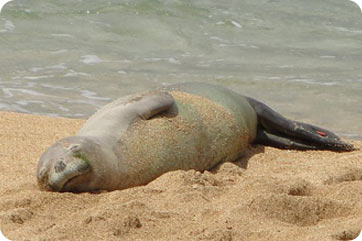190711-monkseal1.jpg

A Hawaiian Monk Seal resting and sunbathing on a beach near Wailua Bay. Credit: Wikipedia
During one of his voyages to the New World, Christopher Columbus spotted a group of “sea wolves” lounging on the beaches of the present-day Dominican Republic. He ordered his men to kill eight of them for food. After that, it was all downhill for the Caribbean monk seal. The last one was seen in 1952, and a species that once ranged from the Florida Keys to the shores of South America has been declared extinct.
Two species of monk seal remain, and they’re both in danger of following their Caribbean kin. Only about 500 Mediterranean monk seals remain, while the Hawaiian seal is in only slightly better shape, with perhaps 1200 survivors.
Monk seals are named for folds of fat around their necks that look like a monk’s cowl. Adults are typically about six or seven feet long and weigh several hundred pounds. They feed in shallow waters on fish, octopus, and crustaceans. And they’re curious and docile -- two factors that have led to their demise. They were easy prey for hunters, who prized their furs and blubber, and for fishermen, who considered them pests.
Most of the Hawaiian seals live in the northwestern islands, more than a thousand miles from Honolulu -- part of a large marine sanctuary. There’s little development in these islands, although the seals sometimes run afoul of fishing operations -- they can become tangled in the nets and drown. That’s just one more threat for a species that’s been disappearing in a hurry.
We’ll talk about the Mediterranean monk seal on our next program.

